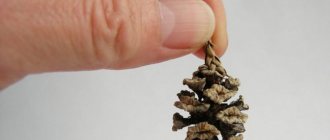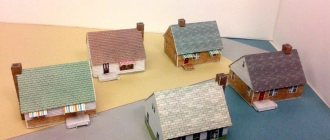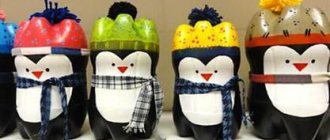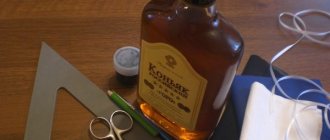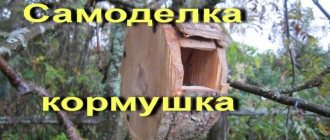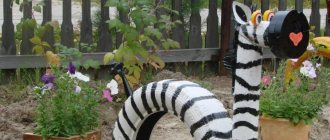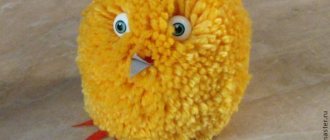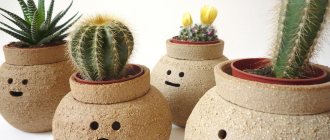Ordinary tree branches, which usually abound in an orchard or garden plot, are a unique material.
Nature has already given them bizarre shapes, which, with the proper imagination and a little skill, can be turned into a real work of art. Crafts made from tree branches will fit into your home decor in an original way and will help diversify and decorate your interior.
Material requirements
Of course, not every branch is suitable for making crafts. It is better to harvest the material in early spring or autumn, when the bark and core are not touched by bark beetles.
There are no requirements for the type of wood: birch, willow, grape and other branches are equally suitable for making crafts. The main thing is that the material has no traces of pests, chips or other defects.
To prevent the appearance of any insect larvae in the house, it is recommended to treat the collected branches with a weakly concentrated solution of potassium permanganate.
To prevent crafts made from branches and driftwood for the interior from warping, the material must be pre-dried. You can do this in two ways:
- in natural conditions, spreading the branches in an even layer on the floor and keeping them at room temperature for about 2 weeks;
- accelerated process - spread on a baking sheet and place in the oven for 3 hours. There must be a low heat and the door ajar so that the moisture comes out evenly.
If you plan to remove the bark from wood for crafts, this operation must be performed before drying begins. When the branches are free of excess moisture, the surface can be coated with wood varnish.
LiveInternetLiveInternet
As you know, furniture and decoration made from natural wood are quite expensive, but the small original pieces from this gallery are very economical and will only require a couple of things from you:
1. the ability to discern potential in the diverse elements of trees (bark and branches, snags and logs), which you may encounter by chance or be selected specifically for a particular product;
2. some time - to search for material and the process of making accessories.
However, we will, of course, help you with the first step. Everything you see here was once also a “semi-finished product,” but the imagination of decorators turned these simple, affordable things into original decor.
If you like not only eco-style, but also reasonable savings, hurry to see how to decorate with wood elements:
- flower vases, candles and table settings;
- photographs, clocks and lamps;
- furniture and walls;
- and also how to create hangers and shelves in a rustic style.
__________________________
original tree bark decor:
As experts say, it is best to separate the bark from a freshly cut or growing tree (stump). If this is not possible, it is advisable to wet the log. The easiest way is to use pieces of bark for serving. It can also be used to wrap vases and flower jars of simple smooth shape (cylindrical and with right angles), or wide candles in neutral tones. The edges are glued or the entire product is tightly wrapped with twine (tape). You can also create unusual containers for flowers from the bark, for example, hanging cones to decorate the garden on the occasion of a wedding or birthday (photo 12).
In addition, pieces of bark can be used to decorate photo frames and even cabinet doors (photo 2), it is simply glued to the surface, the size of the strips does not matter.
1.
2.
3.
4.
5.
6.
7.
8.
9.
10.
11.
12.
__________________________
original decor from branches and thin tree stems:
From the simplest branches collected in the nearest park, you can create amazing compositions in eco-style. If you add sea souvenirs, you get resort-themed decor.
1.
2.
3.
4.
5.
6.
7.
8.
9.
__________________________
original decor from knots and snags:
And such things can be brought back from a vacation at the seaside or near a river. Parts of the trees were separated from them a long time ago, and then were sanded down by water and now look like relics. French decorators love to use them when setting the table, and German decorators love to place them inside flower pots as a top decorative layer.
1.
2.
3.
4.
5.
6.
7.
8.
9.
__________________________
original decor from a cut (cut) of wood:
Even schoolchildren know that the growth rings, which become visible during a cross section, indicate the age of the tree. But to discern the potential effect in them is the talent of a decorator. A collage of thin tree cuts can be used to decorate a wall or stool in an unusual way; thicker and larger ones can become a serving element or can be used as a stand for hot dishes.
1.
2.
3.
4.
5.
6.
__________________________
original decor made from wooden logs:
Side tables and candlesticks (photos 3 and 2) made from logs and logs are sold at Pottery Barn, but you can make something similar with your own hands if you have some woodworking skills. Other options are simpler, but no less decorative.
1.
2.
3.
4.
5.
__________________________
original decor from untreated boards and bars:
And this is a collection of ideas for those who like country style, even if the products are a little rough, but very unusual.
1.
2.
3.
4.
5.
6.
7.
8.
9.
10.
11.
Decorative candlestick
This is the simplest option for making crafts with your own hands. It will take less than an hour to make a decorative ornament. To work you will need:
- glass glass. A container with high and low walls is suitable; it is better to choose transparent glass, but this point remains at the discretion of the master;
- glue;
- thin dry branches;
- small pruner.
At the initial stage, the lower parts of the branches need to be trimmed so that they fit evenly to the bottom of the glass. The proportionality of the upper part does not play a significant role.
The further operation is simple: spread the branches with glue and glue them to the wall of the glass close to each other. The candle is inserted inside the glass container, and an original candlestick for decorating a room or a romantic dinner is ready.
The second version of this craft: the branches are glued directly to the candle. Thin willow twigs, which have a straight shape, are more suitable for this. However, such products are used only as decoration: you should not light a candle covered with dry wood for fire safety reasons.
Original vases
Let's look at ideas with vases. The stunning pieces feature minimalist decor and natural designs.
Various master classes will help you create interesting things to decorate your home. A simple vase can be made from pieces of wood of the same size, glue and a plastic or glass base. You will also need a green plant that can be planted in a container.
Branches should be selected according to the size of the vase. Large elements can be trimmed. The wood is glued to the surface of the container using a glue gun. After this, the plant can be placed inside. Light wood goes well with succulents.
In the photo you can see a version of a vase made from long branches.
The vase can be made from suitable pieces of wood. Flasks of water are inserted into holes in the surface of the wood. Then flowers are placed in containers.
Tall glasses can be an excellent support for a vase. Weaves of branches are attached to a glass surface.
You can make interesting crafts from cut wood.
Photo frames and mirrors
Tree branches can be used to make a beautiful frame for a family photo or a mirror in the hallway. The work is carried out according to an identical scheme, the only difference is in the method of design and the amount of consumables for crafts.
To decorate a photograph, dried and varnished thin branches are glued to a wooden frame.
Note! You can also make the base of the photo frame yourself by cutting out a rectangle from plywood with a jigsaw.
Pasting begins from the long sides. The branches are laid closely; two or three rows are allowed. Then, using a similar pattern, the short sides of the frame are pasted over. At the corners, the ends of the branches can be laid end-to-end or with an intersection; both options look equally interesting. As an additional decoration for the craft, you can use dried moss or any other decoration at the discretion of the craftsman.
In a similar way, you can make an original frame for a mirror. However, here the base has a larger area, and finding relatively straight branches can be problematic. In such cases, the source material can be cut into small pieces (3-5 cm) and the branches can be glued not parallel, but perpendicular to the base. There will be more time to make such a craft from branches, but an ordinary mirror will look elegant and unusual.
Subtleties of choosing craft components
Making crafts from tree branches with your own hands will not encounter any obstacles if you choose the right material. Regulars of such creativity advise the following:
- It is easier to work with wood that contains a sufficient amount of moisture. Willow, birch, and aspen branches have excellent characteristics.
- Pine and spruce are difficult to process. It is advisable to take on the material only if you have experience.
- It is recommended to choose clean branches without growths or resin. It's easier to work with these. They will not damage surrounding objects.
- Branches for crafts must bend and not break. This will save you from mistakes and the need to replace components.
- Twigs with uniform fibers will be suitable. It is advisable to take specimens with the same direction of scales.
To start creative activity, it is preferable to use thin straight twigs. Working with thick, clumsy, forked specimens is worse.
Stands
After cutting down an old tree at your dacha, you don’t need to immediately put it on the fire. From a small part of the trunk you can make an original stand for stationery. To create this craft you will need:
- cutting a trunk with a diameter of no more than 15 cm, a height of 5-8 cm;
- drill with a set of drills;
- fine-grained sandpaper;
- varnish for wood processing.
The workpiece is cleared of bark if necessary, the lower part, which will serve as the base, is leveled to provide stability. Holes are drilled in the upper part, the distance between each is maintained at 5-10 mm. Then all surfaces and corners are sanded with sandpaper. At the final stage, the wood is coated with several layers of varnish, and after drying, the stand for pencils and pens is ready for use.
Hanger
Homemade hangers are ideal for decorating hallways of apartment and private houses and country houses. This is not even a craft, but real carpentry made from tree branches.
For production you will need:
- board. Its length and width are chosen arbitrarily, depending on the amount of clothing that will be placed on the hanger;
- thick tree branches with branch shoots, preferably located at an acute angle.
- self-tapping screws;
- saw;
- paints and varnishes.
The base board must be cut according to the specified dimensions, varnished or painted, having previously treated the surface with sandpaper.
Each thick branch is cut to a length of 30-40 cm, 1-2 shoots are left at the base, which will serve as hooks for clothes. The back surface of the knots can be trimmed to ensure a tight fit to the base.
The hook branches are attached with self-tapping screws; if the homemade hanger is not intended to be used for storing heavy items, you can get by with glue.
Properties and rules for harvesting bark
A little about the features of the material
Pine bark has an interesting structure and color.
Almost all plants are covered with an outer layer of special tissue called bark. This is a protective organ, which in the case of trees consists of dead cells and fibers on the outside, as well as several internal layers, such as cork, primary bark, pericycle, phloem.
The outer hard layer is called the crust.
It serves to protect the barrel from:
- mechanical damage;
- penetration of wood-eating insects;
- parasites.
The inner layers perform various functions, including:
- transport of nutrients;
- protection against temperature changes;
- moisture evaporation.
The structure of a tree trunk.
Important! Bark is a vital organ for a tree, so it cannot be removed from living plants, as it will be quite difficult to restore the tree bark. If significant areas of the cover are damaged or removed, the tree dies.
In terms of its chemical composition, the coating layer has no special differences from wood as such and consists of cellulose, lignin, extractives, hexosans, pentosans and polyuronides.
Accordingly, this material exhibits approximately the same qualities as an array:
- supports combustion;
- does not sink in water;
- conducts heat poorly.
In addition, features are observed - low permeability to moisture, high impact strength and wear resistance.
For simplicity, the structure of the cover can be represented in three main layers:
- crust;
- primary cortex;
- secondary bark.
We won't go into too much biology, just that the different layers can be used in different ways.
Some plant species have a cover of extraordinary beauty.
For household use in making crafts, the outer dead part of the trunks and roots is used, which is easily separated from the main stem.
It can have a different surface character:
- Fibrous;
- Scaly;
- Warty;
- Furrowed.
This diversity gives us fairly wide artistic means and opportunities to create a wide variety of products, designs and decorations.
The surface structure depends on the type of wood, so various types are used to make crafts:
- birch,
- oak,
- pine tree
- maple,
- chestnut, etc.
Snakebark maple has beautiful furrowed bark.
Important! The bark is easy to harvest and process, has a beautiful texture and color, and its price lies only in your personal time spent searching and collecting the material.
Blank
It is important to properly collect and prepare raw materials.
As was said, it is impossible to remove bark from a living tree, as this can cause irreparable harm to the plant and lead to its death. Therefore, to prepare material for crafts, you need to find a dry log or a freshly cut trunk.
You can also go to the nearest park or forest plantation and collect fallen fragments of pine or deciduous bark, which trees periodically shed as they grow. It all depends on what exactly you plan to do.
The fallen bark can be used to make various jewelry and crafts.
It is best to use trees that were cut down no later than two to three weeks ago, since otherwise the cover will be much more difficult to remove.
Here is a short instruction that will tell you how to remove bark from a tree:
- We find a freshly cut healthy tree growing in a moderately humid area of the forest. It should not be too old, but not too young either;
- Depending on the tasks, we determine the size of the required piece of bark. In accordance with this, we make a cut along the trunk, as well as two cuts around the trunk at right angles to the longitudinal cut;
- We carefully pry the bark along the length of the longitudinal cut and begin to bend it, peeling it away from the sapwood;
- Gradually separate the designated piece from the wood. For work, you can use a knife, an ax, a sharpened shovel and a pry bar with a flat end;
- Birch bark - birch bark - can be removed with sbitny. To do this, you need to saw off a piece of wood measuring 40 - 50 cm, then thread a piece of steel wire under the bark and run it around the trunk, separating the cover. Then the log is knocked out of the birch bark cylinder with light blows.
It is more convenient to work with a sharp axe.
Important! If there is a logging operation near you, you can collect bark there, as it is often removed from logs.
Vases
Flower pots and flower vases can also be beautifully decorated with branches. To do this, the branches are cut on both sides so that the source material is the same size. The branches are laid out in one row on the table, tied together with a strong thick thread or twine. To make the structure more presentable and durable, the branches are secured in two places: above and below. If the work is done correctly, you should end up with a path of tightly fitting branches.
A vase or flower pot is covered with burlap. At the final stage, the branches are wrapped around the base, the ends of the twine are tied together with a bow. As an additional decoration, the surface of a wooden craft can be varnished or decorated with decorative elements.
To decorate branches for a vase, make your own paper flowers, then glue them onto the craft. They use cones, old beads, pieces of cotton wool. LED light bulbs look beautiful as illumination for a floor vase.
Furniture made from twigs and driftwood
Not only small objects and decor can serve as objects for DIY crafts made from roots and driftwood. Even furniture is made from similar raw materials.
It is enough to take a close look at this “garbage”. The components of objects can be slightly adjusted and processed. The parts are carefully selected and connected. Driftwood can form part of an object.
Small things can be completed in one piece. In this way, amazing tables, chairs, shelves, and racks are obtained. It’s easy to assemble a unique garden bench or gazebo from the roots of fallen trees.
Not only large pieces of trees can be used as material: roots, branches, but also twigs. Excellent light furniture is woven from wicker.
There are many examples of crafts made from twigs, unusual roots, and driftwood. You can come up with an idea yourself or get it from the Internet. All things in this manner look stylish, unusual, colorful. This option will be a good solution for decorating any interior.
Crafts made from roots and driftwood
Remarkably, a stylish decorative piece or handmade wooden sculpture can be created with a minimum of effort. Stumps, snags, and roots, which remain in large quantities after harvesting trees, will help with this. In fact, the driftwood is already a finished sculpture, which only needs to be cleared of the bark, dried and varnished. Children enjoy searching for interesting shapes. Crafts made from driftwood are suitable for older kindergarten groups and for school.
To create a real masterpiece, just look carefully at the remains of cut down trees. Perhaps the outlines of a fairy-tale dragon, goblin, wolf and other animals and birds will flash in the stump. Having found a suitable material, you will have to do a little work with an ax or chisel to complete the similarity begun by nature. This kind of work should be done by an adult.
What is made from driftwood
Designers actively use wood blanks to create the most incredible objects, products and compositions.
Furniture
Large knotty driftwood makes beautiful and durable tables, chairs, and stools. If you have straight trunks available, they will make an excellent rack.
Only the legs of chairs or a table can be made from small driftwood. A headboard made of wood with a weird shape looks good.
Bed made of driftwood and trunks
Panel
This decor is hung on the wall instead of a painting. To make it, driftwood of various shapes, logs and individual branches are used. Fastening is carried out using nails or reliable glue.
Photo frames
Photos in exclusive frames will make the interior catchy and memorable. You need to take suitable twigs or other parts of the tree and paste over the finished frame, giving it an unusual shape.
Candlesticks and vases
To make a candlestick, you can use a piece of wood of any shape. You need to drill a hole in it and install a candle in a metal frame. Vases are also made from any driftwood, or glued together from thin twigs using hot glue.
Lamps and fixtures
Designers actively use wood to create various lighting fixtures. The most popular are ceiling lamps made from logs, floor lamps and table lamps made from roots, and sconces made from wood cuts.
Watch
The finished clock can be inserted into a natural recess in the wood, or you can first cut a hole with a chisel and then place the mechanism in it. The clock will look like a natural element of driftwood and will become a real highlight of the interior.
Decor
Thanks to their non-standard shape, driftwood will serve as an excellent basis for making decorations for walls, floors, tabletop souvenirs, and three-dimensional figurines. Such creations will fit perfectly into an interior made in eco and country styles.
Driftwood and other materials
Wood combines well with glass, metal, plexiglass, and epoxy resin. For example, a table with a fancy driftwood leg and a tempered glass tabletop looks original and luxurious.
